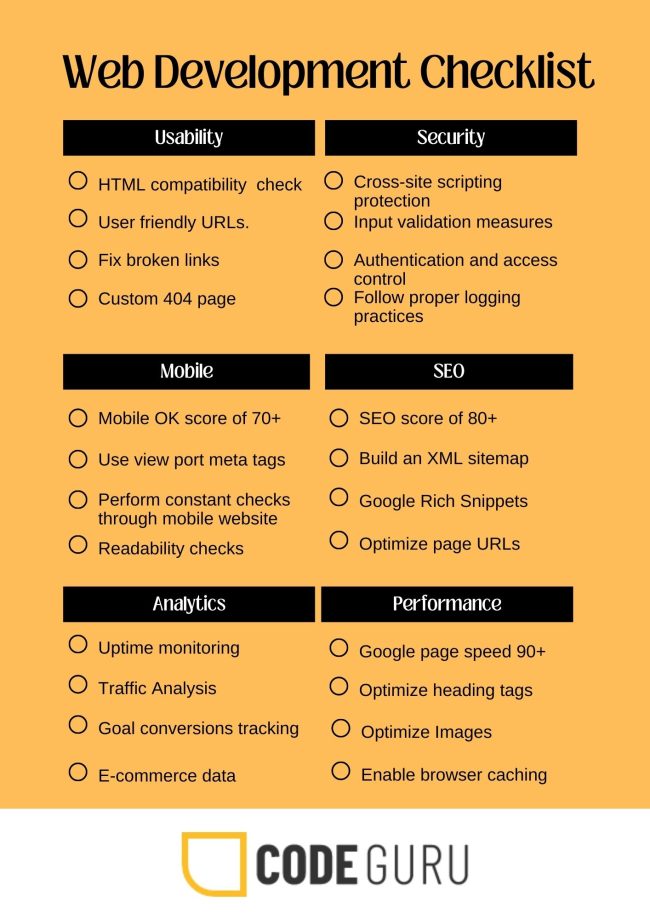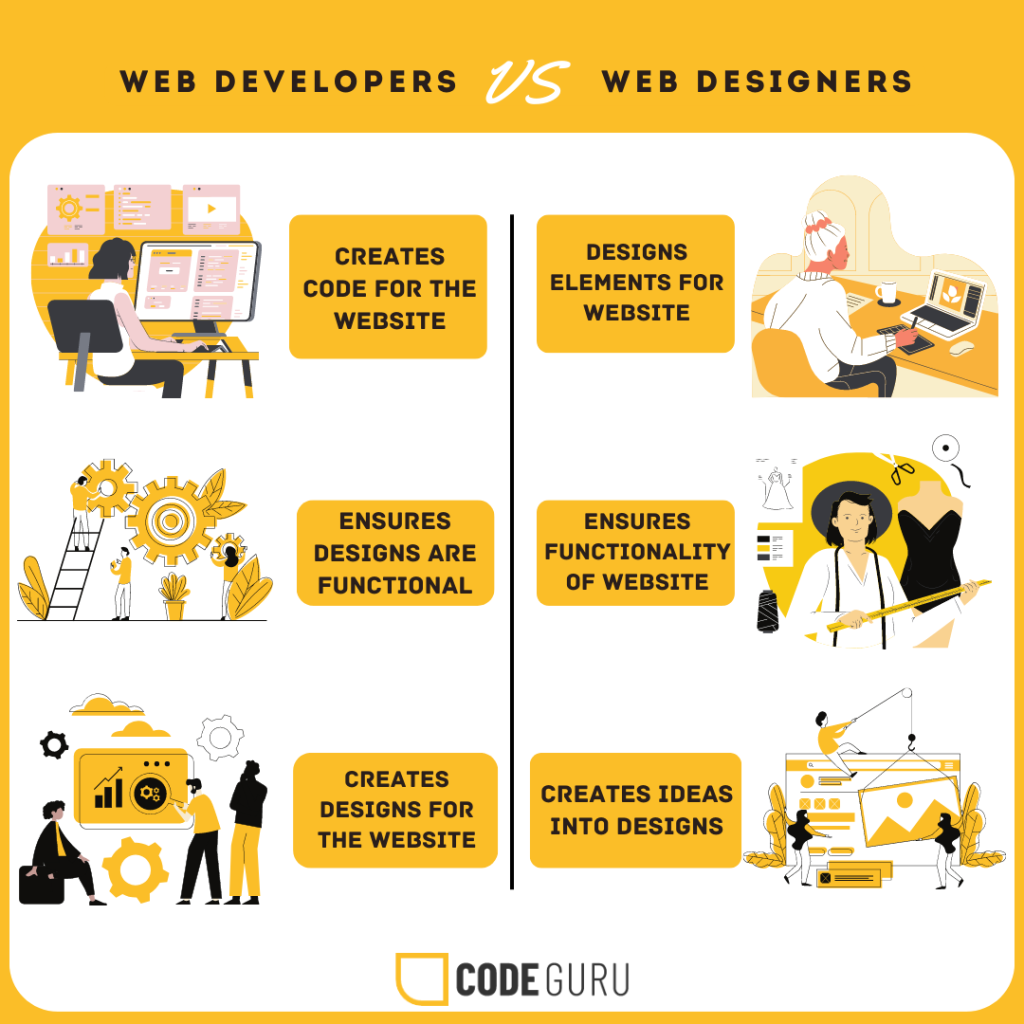A Comprehensive Guide on Web Development
Table of Contents
What is Website Development?
Website development is the creation and maintenance of websites and web applications over the internet. It involves various elements such as web designing, programming, online publishing, and database management.
The term web development is used to describe the building and programming of websites. In order to develop websites, web developers produce code through coding applications, utilize programming languages, and use them accordingly depending on the programs they are working on or the platforms they are working for.

Why is Website Development Important?
Website development in Dubai have become increasingly high in demand because of how fast technology has advanced. Undoubtedly, the internet will continue to advance even further and evolve into a fundamental aspect of all processes.
As the number of internet users rapidly increases, it is no surprise that the demand for website development in Dubai is simultaneously increasing. It is estimated that the website development industry is expected to grow by 13% by the year 2030, which is considered faster than any other technological career.
By 2030, the website development industry is expected to grow by 13%, which is considered faster than any other technological career.
Web Development Basics
1. What is a website?
A website is a collection of web pages published under a single server and accessed through a domain name. Websites can be owned and created by an individual, group, or entire organization.
Websites are usually dedicated to a topic or have a purpose, such as promoting a business’s products or services to its audience. They are a digital network that stores information and allows people from all over the world to interact with each other in a digital space.

2. What is an IP Address?
An IP address, or Internet Protocol address for short, is a unique series of numbers that are given to computers that are connected to a network. This distinctive set of numbers allows the network to identify your computer and its location.
The way an IP address works is by directing data to your computer. For example, when you open a website, the website tries to identify your IP address and sends data to that address for the information to load up on your screen.
3. What is HTTP?
HyperText Transfer Protocol or HTTP is a protocol that helps you connect your computer to a website that hosts and stores the data remotely. It allows you to access and jump between pages on the internet.
HTTP is a translator between you and the website you’re trying to access. When you search for anything on the internet, HTTP will translate the action you’re performing so the server can understand what you’re trying to search.
4. What is Coding?
Coding is the language given to a computer as a set of instructions to perform tasks. Generally, coding is used to program websites and applications users interact with on their devices. Coding must be frequently tested for bugs and optimized regularly to ensure the program functions correctly.
5. What is CMS?
A content management system is software that allows users to create content online without technical knowledge.
Primarily, CMS deals with two components: the front-end user interface, which enables users to modify the content digitally, and the other is a Content Delivery Application (CDA), which updates the website with the content you produce. CMSs are usually used by individuals or organizations to create and manage content on their websites.
6. What is Cybersecurity?
Cybersecurity is the process of securing systems that are connected to a network by trying to reduce the risk of cyber threats. Implementing cyber security is crucial for website development in Dubai since the number of active users and devices connected to the internet continues to grow while the number of cyber-attacks also increases.
Web developers should practice basic principles of cyber security since it could significantly reduce the risks of cyberattacks. Another recommendation would be to host meetings and review online activity consistently.
Types of Developers
1. Front End Developers
Web developers usually focus on two types of development: front-end and back-end.
Front-end development focuses on programming that is directly visible to the user and directly affects the user experience on the website. Front end development is usually mistaken for web designing; however, web designers and front end developers typically work together to create a well-made and interactive website for their users.
Front end developers are responsible for a wide range of tasks that involve working and collaborating with other developers and teams to make a fully functional website. To understand their role better, let’s look at the primary duties of every frontend developer in Dubai:
- Testing for bugs on the website
- Working alongside Graphic Designers, UI/UX developers, and web designers to create a well-structured website for the best viewing experience.
- Ensuring the design is responsive, meaning users can seamlessly view the website on multiple device dimensions.
- Ensuring the website is well structured so that it can take advantage of SEO benefits.
2. Back End Developers
While front end developers focus on what the users see on the website, the back end developers work on what they don’t. Back end developers work behind the scenes and structure the website in a way that cannot be seen. Although not visible, backend developers usually program codes that allow the website to perform. Web development companies in Dubai usually use Python, Ruby, and SQL to perform backend development tasks. They typically create the basic framework on the website so it performs the way it should.
Backend developers ensure the website is functional and performs well by verifying it is fast and responsive. In order to perform those tasks, backend programmers need to know how to build servers with modern frameworks and the management of data on a web server.
3. Full-Stack Developers
On the other hand, full-stack developers perform both front-end and back-end development. Due to this, they can understand a wide range of programming languages. Their versatility allows them to be given leadership roles and look over other developers who focus only on front or backend development. Full-stack developers require years of experience and usually aid the front and backend developers when needed.
4. Website Developers
Website developers are responsible for structuring and maintaining the website. They could be front-end, back-end, or even full-stack developers. Their work involves maintaining the design of the website as well as the technical aspects of the site, such as making sure the site is functional, doing regular maintenance for the website, making sure the website can handle traffic, etc.
5. Desktop Developers
Desktop developers are responsible for developing software that runs on your desktop locally rather than on web browsers. The software created by desktop developers is directly installed on your computer rather than running on web-based applications.
6. Mobile App Developers
These developers are responsible for developing mobile applications. Mobile applications run differently compared to website software and desktop applications and require entirely different skills.
7. Game Developers
Game developers are responsible for designing and developing video games for various platforms such as PCs, mobile devices, and console platforms. The game development process begins with an idea that developers and asset creators then develop for a complete game design.
8. Embedded Developers
These developers are responsible for designing and developing software for embedded systems, such as ATMs, digital cameras, and airbag control systems.
Embedded software is specially designed for specific hardware devices to meet time, size, energy, and memory constraints. They are carefully designed to run for years without being shut down or reset. A few elements that embedded software follow are:
- Real-time: Ensuring that the software receives and processes inputs in a quick rate of succession. Embedded systems need to perform as fast as possible.
- Reliability: Embedded systems must be reliable and perform well during critical situations. For example, self-driving cars need to process data as quickly as possible while making decisions to ensure that passengers in the vehicle are kept safe.
- Fault Tolerance: Embedded software must be able to run during faults such as hardware failures or power cuts. For instance, embedded systems in airplanes need to quickly identify defects and inform the staff about the existing issues to ensure the passengers’ safety.
9. Security Developers
Also termed as ‘ethical hackers,’ security developers are responsible for setting procedures to ensure a website’s safety. They try to find ways to break into the website without causing harm and devise solutions to fix those issues. They strive to impose security measures to minimize the risk of security breaches.
Website Development Lifecycle
The web development life cycle consists of a range of tasks where web developers and designers need to work together to develop a website. The web development process consists of various stages, including but not limited to planning, designing, building, testing, and delivery.

1. Planning
Website developers in Dubai usually plan their goals and objectives before developing the website. It involves a careful analysis that is based on the client’s requirements of how they want their website to be.
The next step is doing research based on your client’s target audience. During the research stage, developers understand the demographics, including their age and preferences. This data will guide web developers to build the best website.
Web developers in Dubai also try to identify what kind of content will attract their clients’ audience. They use this information to create content about their client’s products or services based on their requirements.
2. Designing
Using the information gathered from the planning phase, web designers create visual elements [brand logos], set up brand colors, and other elements that strengthen the brand identity on the website. Website designers in Dubai usually create prototypes to show their clients and alter them, if necessary, to meet their requirements.
The design stage requires a lot of communication and collaboration with the client in order to develop the best website possible.
3. Building
The designs are ready at this stage, and the web developers come into play. Website developers usually take the designs and implement them on the web, ensuring the functionality of the designs on the website. They also take these designs and create animations through Javascript as per the suggestions from the web designing team.
A lot of communication is required between the developers and clients as they can collaborate on updates and ensure they meet the client’s conditions as efficiently as possible. Once development is complete, we move to the testing phase.
4. Testing
Website developers usually perform testing procedures after completing front-end and back-end development. The developers test the web pages for functionality and ensure every link works. All content, including titles and descriptions, affects the website’s overall search rankings.
5. Delivery
Once the website is tested and approved by the client, the development team publishes the site. Prior to publication, it’s essential to ensure that the domain name is registered and that web hosting servers are in place.
Website developers also recommend that after launching the website, you can continue to improve the website by, for example, including plugins for WordPress to manage the content on the website efficiently or installing plugins to track the website’s analytics. You can also constantly update the content on your website to ensure a boost in your search engine rankings.
Website Development Checklist Template
Create the best website for your brand with our simple yet comprehensive website development checklist.

Benefits of a Well-Developed Website
A well-designed website helps you tremendously, especially when we live in a digital environment. The advantages of developing a website are as follows:
☆ Builds Credibility
No matter the size, businesses require a website. Displaying testimonials, customer stories, industry insights, and more can certainly build credibility and trust.
☆ Cost Effective
Building a website is a cost-effective marketing method. Contrary to traditional techniques like billboards or television ads, websites allow you to reach a larger audience at once.
☆ Global Reach
Undoubtedly, one of the promising advantages of building a website is its massive reach. A website creates new avenues for your business, targets multiple demographics, and unlocks a trove of opportunities. In addition to its organic reach, you can also amplify its presence through effective digital marketing strategies.
☆ Increased Sales
In today’s digital world, a well-designed website is key to improving returns. Not only does your business gain an online presence, you can reach a vast audience, provide 24/7 support, share valuable insights, and much more through your website.
☆ Stay Competitive
Beyond maintaining an online presence, a website has the potential to promote your brand, define your brand personality, and demonstrate the USP of your brand. Since most companies prioritize website development, it’s almost impossible for a brand to maximize success without a website.
The Cost of Website Development in Dubai
The cost of website development in Dubai varies on several factors. Some of the deciding aspects are:
- Size and complexity of the website
- Type of website
- Individual agency fees
- Content creation
- Additional features like SEO, social media integration, mobile responsiveness, etc.
As prices vary based on company needs, it’s best to research and shortlist the best website development companies in Dubai and request quotes to finalize your decision.
Web Designing
Although website development and designing have overlapping elements, let’s take a closer look at the primary differences between the two.
Web developers are in charge of writing the code for the front and back end of the website. They implement the designs onto a website that’s created by the design team. In order to perform these tasks, web developers need to understand various programming languages such as HTML, Javascript, Ruby, Python, etc.
Website developers in Dubai are usually required to have a basic knowledge of some coding languages that are widely used, such as HTML, CSS, Javascript, etc.
On the other hand, web designers are responsible for everything related to the website design that the user sees. This usually involves the design, type of font styles used, color, and all other elements that contribute to the site’s appearance.
Web Design Principles
The principles of web design refer to the visual and design rules that web designers follow. Website development in Dubai and other countries usually have different sets of principles depending on their client’s expectations and needs.
Our list compiles a few concepts that you should consider based on the most regularly utilized ones by web designers in Dubai:
• Easy Navigation
Easy navigation is one of the essential features of a good website. In fact, it’s estimated that 38% of people visiting a website for the first time may abandon the site if they experience poor navigation. Therefore, web designers in Dubai highly recommend implementing easy navigation to better user experience, increase content exposure, and reduce overall bounce rates on site.
• Engaging Pages
Although web designers usually maintain consistent elements across all their pages, it’s best to modify individual pages to make them interesting for the visitors. Some simple steps to develop engaging pages include utilizing colors strategically, using white space smartly, incorporating attractive multimedia, etc.
• Personalized Design
If you analyze some of the best websites from UAE, you can see that each offers a unique “feel.” This distinctive feel comes from tailoring the website perfectly for their target audience. In fact, research shows that 82% of customers are more likely to value companies that align with their values and beliefs. Therefore, personalization is one of the fundamental goals of website design. Consider the images, tone, content, and CTAs you choose to make your website more personalized for your audience.
• Font Styles
Typography accounts for 95% of a website. Great typography sets a visual hierarchy, strikes a graphical balance, and determines the overall tone of the website. Since it holds tremendous value, it’s crucial to choose the right style that represents your brand. To select the right font style, consider your brand identity and tone, typeface pairing and contrast, legibility, and readability.
• Clear CTAs
Call-to-action, or CTA, is an essential element in web design. Placing too many CTAs may come off as intrusive, and having too little may make it complicated for users to navigate your site. Therefore, understanding the correct number, placement, style, and content of your CTA requires serious planning and action. To create clear CTAs, experience your website from your customer’s perspective. Ensure they are natural, descriptive, and spark curiosity when needed.
Web Designing vs. Web development
A simple infographic that distinguishes the primary differences between website development and website design.

Web Security
Security is essential to prevent unauthorized users from accessing the website, changing data, and leaking information. There are frequent occurrences that hit headlines of big companies having their data leaked, and this is one of the main reasons web developers prioritize the implementation of web security in the initial stages of development.
Looking at reports from “2023s Global State of Cybersecurity”, around 66% of companies of website development in Dubai have reported data breaches in the past year.
Web Security Threats
Although there are several ways to breach security, here are the common web security threat tactics employed by unauthorized users.
☒ Credential Stuffing
Credential stuffing is when an attacker uses a list of compromised data to breach the system. This method is based on the assumption that users reuse login IDs and passwords across multiple sites. The attacker uses bots for automation and scale.
☒ Brute Force Attacks
Similar to credential stuffing, in brute force attacks, the hacker uses a trial-and-error method to decode passwords, login credentials, and encryption keys.
☒ SQL Injections
SQL injections or SQLi is a cyber attack whereby the user interferes with queries made by the application to its database. Generally, SQL injections allow the attacker to view unretrievable data belonging to either a user or organization and modify or delete data. In many cases, SQL injections lead to persistent changes to the application’s content and functionality.
☒ Cookie Poisoning
Cookie poisoning, also known as session hijacking, is when an attacker modifies, forges, or hijacks a valid cookie sent back to a server to steal data, dodge security, or both.
☒ MITM Attacks
A man-in-the-middle or MITM attack is when a perpetrator intercepts a conversation between a user and an application to either eavesdrop or impersonate one of the parties. The primary goal of this cyberattack is to gain personal information that can be later used for identity theft, unapproved fund transfers, or illicit password changes.
Best Web Security Practices
As understood from above, there are several ways to breach website security; in fact, there are over 50 types of cyberattacks. So, it isn’t surprising that web developers are implementing the best practices to shield their sites. Here are some of the ideal web security techniques to follow:
1. Encryption of Confidential Information
Don’t stop at HTTPS and HSTS encryption; instead, implement SSL encryption for all data you send and receive from the server. Although HTTPS is excellent and protects against MITM attacks, it’s futile if someone has or gains access to your server. Therefore, it’s crucial to encrypt and hash your data if someone has access, like a former employee.
The only negative of encrypting data is that it creates performance issues. To combat this problem and maintain the website’s performance, web developers in Dubai usually perform risk assessments to identify important information that must be encrypted.
2. System to Track Logs
Considered as detailed dairies of websites, logs provide invaluable insights to site owners and administrators. These logs capture data like the user’s IP address, request methods, response code, etc. An effective logging system will allow you to track vital data that can help during a breach. It’s also essential to secure the log to reduce its risk of being tampered with.
3. Employee Education
Human error is inevitable. That’s why it’s essential to train employees on website security. Access to helpful resources, training materials, and others will allow your team to respond effectively during security threats.
4. Manage Permissions
Managing permission is another excellent website security practice. It’s best to create a permission tier to provide access to employees they need for work. The benefit of granting access comes in twofold.
Firstly, if someone attacks your website through an employee’s credentials, you can guarantee that the attacker cannot go further than what is allowed. Secondly, if an employee tries to breach your website, you can know that they cannot access every sensitive information solely through their account.
It’s also recommended to change passwords once an employee leaves the company.
5. Plan for the Worst
Even though we might have employed the best security practices, we must always prepare for a downfall. Not having a proper crisis response can lead to several other implications, like loss of money and time, delayed response to attacks, and loss of trust. Therefore, create an effective crisis plan that details the type of response and time required for each security breach. In addition to planning a response, it’s also best to test it regularly for its efficiency.
6. Create Backups
Creating backups is one of the basic steps of website security. Regular backups ensure you always have the latest copy of your website to use after a breach. Typically, web developers perform weekly backups when there is the least amount of activity on the webpage.
The Future of Website Development in Dubai
Without a doubt, website development in Dubai has certainly evolved from its initial format. The pages are smooth, the elements are interactive, the themes are diverse, etc. But like all things digital, website development will never stop transforming. Let’s take a quick look at some of the web development trends that website development companies in Dubai will adopt in the years to come:
Accelerated Mobile Pages
Accelerated Mobile Pages, or AMP, is a Google-led open-source project that promotes mobile-friendly websites and pages. In simple terms, AMPs load relevant information and remove unnecessary data; for instance, AMPs only load images when the user reaches the section where they must be viewed. By adopting AMPs, the user can load pages much faster and engage better, thus enhancing the overall experience.
Artificial Intelligence
AI technology is quickly grasping all industries, and web development is no exception. Here are a few ways AI helps website development:
- Improving the coding process by making it faster and more efficient with fewer errors.
- Simplifying web designer’s tasks by assisting them in developing designs and structure.
- Developing SEO-friendly websites by offering content ideas, sharing tips, and improving strategies for web developers.
Motion UI
Motion UI is a popular web development trend that has overtaken the industry. It is a SAAS library that leverages movement and animation within an interface to enhance the overall user experience. Motion UI comes in various preset animations that can be customized, thus simplifying designers’ tasks but not limiting their creativity.
Voice UI
The latest trend in web development, voice UI, creates a more accessible and convenient website for users by allowing them to engage with the site through voice. Voice UI is an excellent feature for those with sight impairments.
Web Development Courses and Communities
If you’re eager to explore new skills or aspire to grow in your career, the internet has excellent resources for you! From free online classes to dedicated group discussions, you have everything you need to thrive in website development. Here is our list of the best resources for website development in Dubai:
Coursera
One of the leading online learning platforms, Coursera, offers lectures on everything from art to science. Some of the best website development courses at Coursera are:
- Web Design for Everybody: Basics of Web Development & Coding Specialization by University of Michigan
• Duration: 3-6 months
• Skills you’ll gain: Web Development, HTML and CSS, JavaScript, Computer Programming, Web Design
• Certification: Yes - HTML, CSS, and JavaScript for Web Developers by John Hopkins University
• Duration: 3-6 months
• Skills you’ll gain: Web Development, HTML and CSS, JavaScript, Computer Programming, Web Design
• Certification: Yes - Introduction to Web Development by UC Davis
• Duration: Not specified
• Skills you’ll gain: Web Development
• Certification: Yes
edX
Like Coursera, EDX is another popular online learning platform offering a range of courses across multiple fields. Some of the best website development courses provided by EDX are:
- Front-End Web Developer Professional Certificate by World Wide Web Consortium
• Duration: 7 months
• Skills you’ll gain: Web development, HTML5, CSS, JavaScript
• Certification: Yes - Full Stack Developer Professional by IBM
• Duration: 7 months
• Skills you’ll gain: Full-stack web development
• Certification: Yes
Khan Academy
A nonprofit online learning platform, Khan Academy, offers free education resources to its users. One of the best courses on website development by Khan Academy is
- Computer Programming
• Duration: 15-40 hours, self-paced
• Skills you’ll gain: ProcessingJS library, programming concepts and principles, JavaScript programming language, writing clean code
• Certification: Yes
Zabeel Institute
Zabeel Institute is perfect for website developers in Dubai who need a blend of in-person and online learning. Certified by the Ministry of Education in Dubai, Zabeel Institute offers training in various fields, including website development.
Egghead
Egghead is a well-known education platform that covers everything about technology, from programming to software engineering.
Our list of the best website development communities is as follows:
- Stack Overflow
- Mozilla Development Network
- Github
- Hackermoon
- Hasnode
- Dev.to
Better Your Website Development Skills – 5 Simple Tips
Whether a beginner or expert, there’s always room for growth. Here are our top tips to always be ahead in your website development career:
Always Learn
Learning is one of the most essential steps in your website development journey. As technology evolves, it’s crucial to refresh your knowledge and understand this dynamic field. From listening to educational podcasts to meeting experts, there are a million ways to sharpen your skills.
Work with Open-Source Projects
Working on open-source projects is an excellent method to strengthen your skills and gain knowledge. As you contribute to ongoing projects or start a new one, you get the chance to collaborate with experienced programmers. Moreover, working on open-source projects will also help you build an outstanding portfolio, which will be helpful in your career.
Follow Trends
We welcome every year with a set of new trends. And as a member of a dynamic industry, it’s essential to keep up with these trends to better your skills.
Learn SEO Strategies
In order to succeed nowadays, you must master multiple crafts. And when it comes to website development, SEO is an important tool you must learn.
Enjoy Your Work
Finally, to shine at work, you must enjoy what you do. Learn to love your craft and enjoy every learning curve. Work on projects that inspire you and spark your curiosity. Work is always fun when you enjoy!
And, on that positive note we conclude our very long and informative guide on website development. Please feel free to email us your thoughts/questions and share this article with your friends if you found it helpful.
FAQs on Website Development
Q1. Can I learn web development myself?
Of course! With the internet thriving with knowledge, web development is certainly a skill you can acquire. Check out the resources we mentioned above in the section ‘Website Development Courses & Communities’ or do independent research online. Happy learning!
Q2. Is web development easy for beginners?
With the amount of resources available, it’s definitely possible to simplify web development for beginners.
Q3. How do you start a web development career with no experience?
If you want to get into website development in Dubai and have no experience, it’s best to solidify your foundation. Browse through courses or begin learning about HTML, CSS, and Java. As you progress, move ahead to other fundamental topics of website development. Once you’re ready, find internships or other opportunities that allow you to grow and learn.
Q4. What should a beginner web developer know?
As a beginner, it’s important to understand the principles of website development before focusing on other areas. Once a solid foundation is set, you can branch out to areas that interest you and better your knowledge in your chosen field. However, it’s recommended not to restrict yourself to one role, as mastering several skills is key to career growth!
Q5. What’s the scope of website development in Dubai?
The scope of web development is vast. It includes several developmental activities like client & server scripting, security development, e-commerce development, etc. The advancements in technology allow web development scope to expand continually.
Q6. What aspect of web development is most important?
It’s impossible to determine which aspect of web development is more important than the rest, as each plays a crucial role in the process. However, if we aren’t limited to one answer, here are a few essential elements of website development:
- Front-end development
- Back-end development
- Web Designing
- Coding
- Bug testing
- Improving UI Experience
Q7. Do websites require maintenance?
Yes. The website requires regular maintenance to ensure its functionality, reduce security breaches, backup data, and detect and correct any issues.
Q8. If I perform regular maintenance, can hackers still access my website?
Although regular maintenance reduces the risk of cyberattacks, one can never be too sure. That’s why it’s vital to follow the best web security practices and develop a crisis response in case of a breach.
About CodeGuru
Codeguru.ae is a leading website development and design company that offers a range of services to help businesses establish a strong online presence. With a team of highly skilled developers and designers, they specialize in creating custom websites that are visually appealing, user-friendly, and optimized for search engines.
Their services include website design, development, e-commerce solutions, content management systems, and mobile app development. They use the latest technologies and tools to ensure that their clients’ websites are fast, secure, and responsive across all devices.
If you’re looking for a reliable and professional website development and design company, Codeguru.ae is definitely your best choice!





